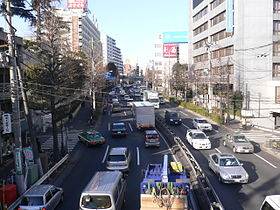Suginami
| Suginami | |||
|---|---|---|---|
| special ward of Japan (en) | |||
 | |||
| |||
| Administrazioa | |||
| Estatu burujabe | |||
| Metropolitan prefecture | |||
| Alkatea | Satoko Kishimoto (en) | ||
| Geografia | |||
| Koordenatuak | 35°41′58″N 139°38′11″E / 35.6994°N 139.6364°E | ||
 | |||
 | |||
| Azalera | 34,02 km² | ||
| Mugakideak | Musashino, Mitaka, Setagaya, Shibuya, Nakano eta Nerima | ||
| Demografia | |||
| Biztanleria | 583.609 (2021eko martxoaren 1a) | ||
| Dentsitatea | 15.834,39 bizt/km² | ||
| Informazio gehigarria | |||
| Sorrera | 1947ko maiatzaren 3a, 1943ko uztailaren 1a eta 1932ko urriaren 1a | ||
| Ordu eremua | UTC+09:00 | ||
| Hiri senidetuak | Nayoro (en) | ||
| http://www.city.suginami.tokyo.jp/english/e-index.html www.city.suginami.tokyo.jp | |||
Suginami (japonieraz: 杉並区 Suginami-ku) Tokio hiriko 23 auzo berezi bat da. 2011ko erroldaren arabera 34'02 km²-tan 538.703 biztanle zeuden.
Geografia
[aldatu | aldatu iturburu kodea]Tokio Hiriko mendebaldean kokaturik dago auzoa. Kanda ibaiak zeharkatzen du eta Zenpukuji eta Myoshoji ibaiak sortzen dira bertan.
Historia
[aldatu | aldatu iturburu kodea]Suginami izena Edo Aroan sortu zen, hasiera batean Suginamiki izena izan bazuen ere, zeinak "zedroen etorbidea" esan nahi duen. Tadayoshi Okabe lordak landatu arazi zituen zedro hauek bere lurrak mugatzeko.
Suginami auzoa 1947ko martxoaren 15ean eratu zen. 1970an smog fotokimikoa sufritu zuten 40 ikaslek eta ospitalizatuak izan ziren.
Kirolak
[aldatu | aldatu iturburu kodea]Takanohana Kōji sumo borrokalari handia bertakoa da. Yokozuna titulua eskuratu ondoren 49 borroka jokatu zituen, historiako laugarrena bihurtuz.
Ondasun nabarmenak
[aldatu | aldatu iturburu kodea]- Suginami Kokaido: Japongo Orkestra Filarmonikoaren egoitza den kontzertu aretoa.
- Suginami Animazio museoa.
Kanpo estekak
[aldatu | aldatu iturburu kodea]- (Japonieraz)(Ingelesez) Suginami auzoko webgune ofiziala[Betiko hautsitako esteka]
| Tokio prefektura |
|---|
| Auzo bereziak : Adachi | Arakawa | Bunkyō | Chiyoda | Chūō | Edogawa | Itabashi | Katsushika | Kita | Kōtō | Meguro | Minato | Nakano | Nerima | Ōta | Setagaya | Shibuya | Shinagawa | Shinjuku | Suginami | Sumida | Taitō | Toshima | ||
| Hiriak : Akiruno | Akishima | Chōfu | Fuchū | Fussa | Hachiōji | Hamura | Higashikurume | Higashimurayama | Higashiyamato | Hino | Inagi | Kiyose | Kodaira | Koganei | Kokubunji | Komae | Kunitachi | Machida | Mitaka | Musashimurayama | Musashino | Nishitōkyō | Oume | Tachikawa | Tama | ||
| Suprefeturak : Nishitama | Hachijō | Miyake | Ogasawara | Ōshima |
Text is available under the CC BY-SA 4.0 license; additional terms may apply.
Images, videos and audio are available under their respective licenses.


